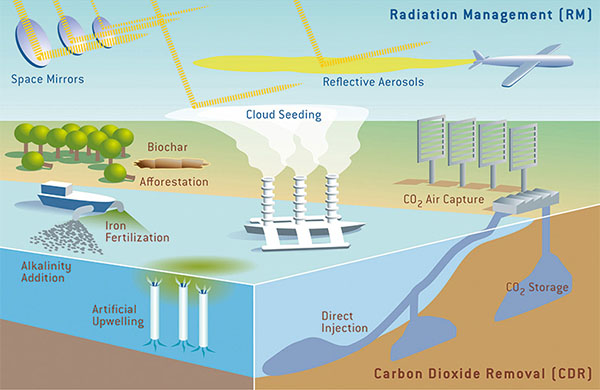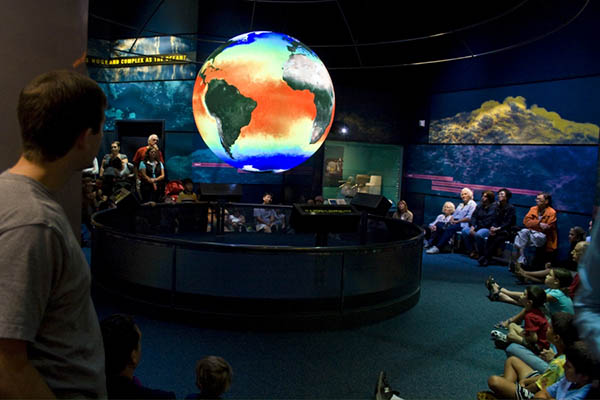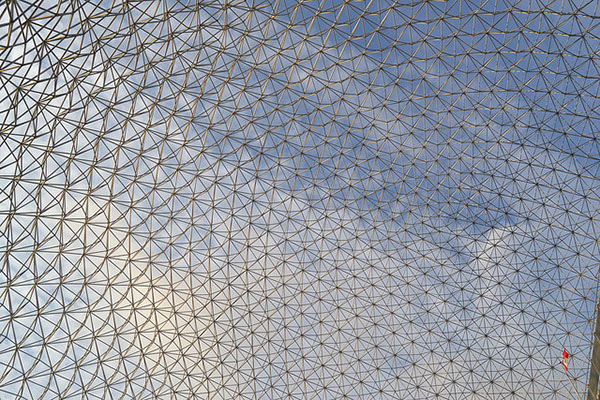Geoengineering [1] is a diverse set of environmental technologies proposed to intervene strategically in Earth processes in order to combat climate change. Take for example, a plan to reduce solar radiation via aerosol clouds emitted from airplanes, or one that attempts to remediate ocean acidification by means of algae blooms created by dumping iron from ships. But like the anthropocene, geoengineering is an ambiguous term. Social scientists seem to criticize both the anthropocene and geoengineering as much as they praise them. However many “Good Anthropocenes” emerge in climate discourses, there are just as many millennarist visions [2]. Just as geoengineering is argued to be an expression of capitalist eco-colonialism [3], others welcome its opening towards new relations with/in earth-systems [4].

Image: Examples of geoengineering. Source: Kiel Earth Institute / Geomar. Wikimedia Commons.
But since geoengineering eludes the confines of a single attitude, historical precedent, or political motive, it may not be analytically prudent to treat as a totality. Thus anthropological inquiry, never content with reductionist critique or blind advocacy, could be especially adept at understanding this thing called geoengineering. This might be possible, in an admittedly indulgent yet I believe necessary fashion, by defining and differentiating its characteristics using a particular rubric: a Foucault-indebted biopolitics. Biopolitical analysis, always concerned with the specificities of a given apparatus, could allow an anthropologist to drive a stake between two geoengineering proposals’ different political histories perhaps, or conversely, to uncover common economic practices hidden in otherwise unrelated proposals, for example.
Biopolitical Earth System Milieu
Foucault’s biopolitics, very briefly, refers to control apparatuses of living populations, often through non-governmental extensions of State institutions, i.e., “governmentality.” [5] The classical biopolitical logic of “letting die and making live” typically refers to living bodies and populations of humans, and perhaps animals too [6]. But in one particular passage in Foucault’s late lectures at Collège de France, he laid groundwork for a potential biopolitical program of protection (and also of potential exclusion) involving living systems of vastly different scales and types.
Biopolitics’ last domain is, finally… control over relations between the human race, or human beings insofar as they are a species, insofar as they are living beings, and their environment, the milieu in which they live. This includes the direct effects of the geographical, climatic, or hydrographic environment: the problem, for instance, of swamps, and of epidemics linked to the existence of swamps throughout the first half of the nineteenth century. And also the problem of the environment to the extent that it is not a natural environment, that it has been created by the population and therefore has effects on that population [7].
Foucault, oriented historically, refers to a governmentality that uses technologies to control and regulate milieus of relatively smaller scale: questions of water supply, air quality, etc., for a relatively closed population. Work on Foucauldian environmentality and eco-governmentality in the 1990s advanced this concept [8]. I presume however, that given today’s rise of the heavyweight mega-discipline Earth system science, conceptualizing a biopolitical field on a larger, dynamic, earth system(s) scale is warranted [9]. Geoengineering’s earth-system scale interventions would thus be an appropriate target of biopolitical analysis. While this is a dramatic twist of Foucault’s conception of biopolitics, I avoid adding a qualifying prefix and leave the word as it is, not just to satisfy the occamist, but also to apply Foucault’s quintessential ambiguous position of biopolitics to the case of geoengineering, which is also, I believe neither solely affirmative nor essentially negative.

Image: The Earth system panopticon? Source: woodlywonderworks on Flickr. Some Rights Reserved.
Ocean Pastoral
Take Russ George’s ocean fertilization experiment, one of the few contemporary geoengineering experiments ever to be performed, albeit illegally. George, a citizen-scientist/entrepreneur deemed “the rogue geoengineer” by media outlets, led a team that dumped 120 tons of iron sulfates into the Pacific Ocean off the coast of British Colombia in 2012. Partially based upon historical observations of oceanic iron levels and associated algae blooms, the iron dumped was intended to stimulate phytoplankton growth, which in turn would encourage healthy salmon runs, which would benefit the general stability and productivity of earth systems. Remarkably, the salmon runs along the Pacific Coast after the experiment were the most productive in decades. But since George avoided normal institutional apparatuses, and given the experiment’s questionable legality, scientific communities pay little attention to his claims of success.
This project appears to be classically biopolitical in that it is a strategic intervention in a milieu for the benefit of a population. George’s own writings about the experiment encourage this association. He frequently uses the phrase “ocean pastures” to refer to the project and his own practice as analogous to a “shepherd”—making his connection to one of biopolitics’ roots: the (pre)Christian Pastoral that Foucault incessantly detail s[10], all the more evident.
Stratosphere Immunity
Another technique, stratospheric aerosol injection, which is intended to strategically “dim” solar radiation from penetrating the stratosphere by means of aircrafts emitting aerosol clouds, points towards a different biopolitical dimension. Its proponents and technologies emerged out of Cold War weather manipulation research at the famous Lawrence Livermore Laboratory [11]. David Keith, an atmospheric scientist at Harvard (funded by Bill Gates among others) is the proposal’s most prominent advocate. Keith’s proposed modification of earth system(s) is legitimized not by field data, but by an emerging, elite institutional web of geoengineering researchers at MIT, Harvard, Oxford, and Cambridge among others. Perhaps due to utter necessity, its common source of evidence depart from a statistically-oriented biopolitics, towards scenario planning; a comparative, future oriented analytical method of planning that focuses on contingency and risk—a self reflexive sort of biopolitics that also emerged during the Cold War [12]. In a quintessentially biopolitical moment in his polemic, A Case for Climate Engineering (2013), Keith draws a scenario in which stratospheric aerosol injection is justified in the killing of some humans (those predisposed to respiratory illnesses; the elderly, children, and the underprivileged in general, not to mention other life forms) for the sake of humanity, or perhaps broadly the earth-system as such [13]. Foucault’s emphasis on the essential Othering aspect of the biopolitical, whereby protection is always accompanied by exclusion of an Other, is revealed through stratospheric aerosol injection. Despite its globalist aims, the immunization of the stratosphere would not protect everyone.

Image: La Biosphère de Montréal. Source: Alvaro Blanes on Flickr. Some Rights Reserved
This brief comparison suggests that the tendency to classify a multitude of ecological interventions as geoengineering may have unwanted effects. When geoengineering projects are generalized, reasonable excitement for one proposal potentially smooths over the unsavory political connotations of another. Or perhaps the dubiousness of one rogue experiment’s scientific data becomes forgotten when in the same lexical category as projects developed within large institutional apparatuses. And what about the other techniques classified as geoengineering, such as planting more forests? Have we not always been geoengineering, as Kim Stanley Robinson suggests [14]? Taking geoengineering to its practical limit, would not a carbon tax also fit the definition, by strategically intervening in an interactive component of earth-systems (society) with the intent of remediating ecological effects? Since geoengineering refers to actual practices—practices that are too complex and diverse to be treated as simply one static category—any writing about geoengineering must be careful to make clear its diversity, in both a political, historical, and technical sense among others, of such projects.
Classifying a specific project’s biopolitical procedures, which are undoubtedly shifting and fluid—and only meanderingly alluded to here [15] may uncover overlooked patterns and specificities of geoengineering projects. But even so, Foucault’s incessant ambiguity lingers, via philosopher Roberto Esposito’s fundamental enigma of biopolitics: at what point does a politics of life become a politics of death—is this a politics of life or a politics over life [16]? I believe this is the only question we can ask of geoengineering when speaking of its generalized form.
Endnotes
[1] Climate engineering is sometimes used interchangeably with geoengineering, though it seems geoengineering is used slightly more frequently.
[2] Grove, Jairus. “Of an Apocalyptic Tone Recently Adopted in Everything: The Anthropocene or Peak Humanity?” Theory & Event 18 (3), 2015.
[3] Klein, Naomi. This Changes Everything: Capitalism vs. The Climate. New York: Simon & Schuster, 2014: 256-292.
[4] Buck, Holly. What Can Geoengineering Do for Us? Public participation and the new media landscape. 2010. Retrieved from http://www.umt.edu/ethics/EthicsGeoengineering/Workshop/articles1/Holly%20Buck.pdf
[5] Foucault, Michel, Mauro Bertani, Alessandro Fontana, François Ewald, and David Macey. ” Society Must Be Defended”: Lectures at the Collège de France, 1975-1976. Vol. 1. Macmillan, 2003: 242-64.
[6] Wolfe, Cary. Before the law: Humans and other animals in a biopolitical frame. University of Chicago Press, 2012.
[7] (emphasis added) Foucault, Michel, Mauro Bertani, Alessandro Fontana, François Ewald, and David Macey. “Society Must Be Defended”: Lectures at the Collège de France, 1975-1976. Vol. 1. Macmillan, 2003: 244-5.
[8] See especially, Darier, Eric ed. Discourses of the Environment. Blackwell Publishing, 1999.
[9] Lövbrand, Eva, Johannes Stripple, and Bo Wiman. “Earth System governmentality: Reflections on science in the Anthropocene.” Global Environmental Change 19, no. 1 (2009): 7-13.
[10] Foucault, Michel, Michel Senellart, Graham Burchell, François Ewald, and Alessandro Fontana. Security, Territory, Population: Lectures at the Collège de France 1977–1978. Vol. 4. Macmillan, 2009. 123-191.
[11] Hamilton, Clive. Earthmasters: the dawn of the age of climate engineering. Yale University Press, 2013.
[12] Collier, S. J., and A. Lakoff. 2014. Vital Systems Security: Reflexive Biopolitics and the Government of Emergency. Theory, Culture & Society 32(2): 19–51.
[13] Keith, David. A case for climate engineering. MIT Press, 2013: 71-2.
[15] Agamben’s bare life; Boyer’s energopolitics; Esposito’s (auto)immunitary logic; Olson’s ecobiopolitics; and Rabinow and Rose’s molecularized biopower might be just a few examples of biopolitically related structures that could be relevant for characterizing modes of geoengineering.
[16] Esposito, Roberto. Bios: Biopolitics and philosophy. U. of Minnesota Press, 2008: 11.
Eliot Storer is a Ph.D. student in Rice University’s sociocultural anthropology department. He studies environmental management practices and energy systems.

1 Trackback